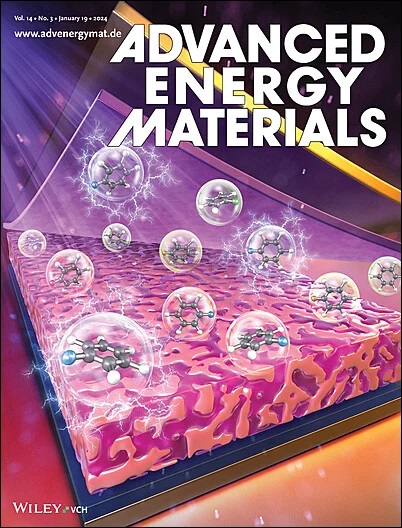Improving Cycling Stability of Ni-Rich Cathode for Lithium-Metal Batteries via Interphases Tunning
IF 24.4
1区 材料科学
Q1 CHEMISTRY, PHYSICAL
引用次数: 0
Abstract
Combining Li-metal anodes (LMAs) with high-voltage Ni-rich layered-oxide cathodes is a promising approach to realizing high-energy-density Li secondary batteries. However, these systems experience severe capacity decay due to structural degradation of high-voltage cathodes and side reactions of electrolyte solutions with both electrodes. Herein, the use of multi-functional additives in fluoroethylene carbonate-based electrolyte solutions that enable the operation of successfully rechargeable high-voltage (4.5 V) Li-metal batteries (LMBs) with high areal capacity (>4 mAh cm−2) are reported. Customized electrolyte solutions are pivotal in passivating the electrodes, minimizing microcrack formation, and ensuring that current is uniformly distributed within cathode particles. The developed electrolyte solution protects the LMA by forming a very stable and effective solid–electrolyte interphase. Together with the Li[Ni0.78Co0.1Mn0.12]O2 cathode material, which is composed of radially aligned rod-shaped primary particles, the developed high-voltage LMB containing 20 mg cm−2 of cathode material delivers a high specific capacity of 230 mAh g−1 at 0.1 C and retains >86% of its initial capacity after 200 cycles at 0.5 C. This study highlights the significance of controlling the interfacial structure via electrolyte solution modification and the use of cathode materials with engineered morphologies that enhance mechanical stability.

通过相间调谐提高锂金属电池富镍阴极的循环稳定性
将锂金属阳极(LMA)与高电压富镍层状氧化物阴极相结合是实现高能量密度锂二次电池的一种可行方法。然而,由于高压阴极的结构退化以及电解质溶液与两个电极的副反应,这些系统会出现严重的容量衰减。本文报告了在基于碳酸氟乙酯的电解质溶液中使用多功能添加剂,成功实现了可充电的高电压(4.5 V)锂金属电池(LMB)的运行,并具有较高的平均容量(>4 mAh cm-2)。定制的电解质溶液在钝化电极、减少微裂纹形成以及确保电流在阴极颗粒内均匀分布方面起着关键作用。所开发的电解质溶液可形成非常稳定和有效的固态电解质相,从而保护 LMA。与由径向排列的棒状原生粒子组成的锂[Ni0.78Co0.1Mn0.12]O2 阴极材料一起,所开发的高压 LMB 含有 20 mg cm-2 的阴极材料,在 0.1 C 时可提供 230 mAh g-1 的高比容量,并且在 0.5 C 时循环 200 次后仍能保持 86% 的初始容量。
本文章由计算机程序翻译,如有差异,请以英文原文为准。
求助全文
约1分钟内获得全文
求助全文
来源期刊

Advanced Energy Materials
CHEMISTRY, PHYSICAL-ENERGY & FUELS
CiteScore
41.90
自引率
4.00%
发文量
889
审稿时长
1.4 months
期刊介绍:
Established in 2011, Advanced Energy Materials is an international, interdisciplinary, English-language journal that focuses on materials used in energy harvesting, conversion, and storage. It is regarded as a top-quality journal alongside Advanced Materials, Advanced Functional Materials, and Small.
With a 2022 Impact Factor of 27.8, Advanced Energy Materials is considered a prime source for the best energy-related research. The journal covers a wide range of topics in energy-related research, including organic and inorganic photovoltaics, batteries and supercapacitors, fuel cells, hydrogen generation and storage, thermoelectrics, water splitting and photocatalysis, solar fuels and thermosolar power, magnetocalorics, and piezoelectronics.
The readership of Advanced Energy Materials includes materials scientists, chemists, physicists, and engineers in both academia and industry. The journal is indexed in various databases and collections, such as Advanced Technologies & Aerospace Database, FIZ Karlsruhe, INSPEC (IET), Science Citation Index Expanded, Technology Collection, and Web of Science, among others.
 求助内容:
求助内容: 应助结果提醒方式:
应助结果提醒方式:


